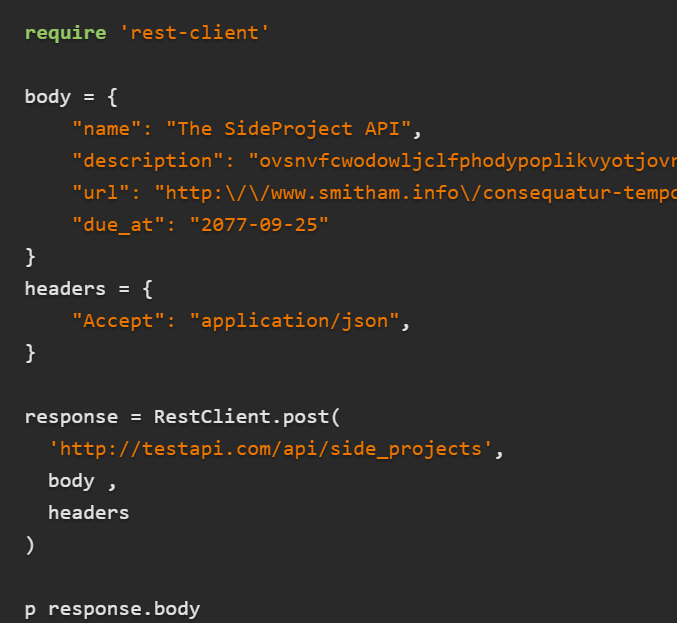Example requests
For each endpoint, an example request is shown in each language in your config. If you aren't happy with the generated examples, you can change the template Scribe uses. You can also add a language which isn't included with Scribe by creating your own Blade template.
In this guide, we'll try it out by creating a template for Ruby. If you just want to edit an existing template, you should follow along, as it's almost exactly the same process.
Step 1: Create template file
First, create a file called {language-code}.md.blade.php in the resources/views/vendor/scribe/partials/example-requests directory. Since we're creating a Ruby template, we'll create in this case, ruby.md.blade.php.
If you're editing an existing template, you can copy the one Scribe uses to create your own template.
You can also run php artisan vendor:publish --tag=scribe-examples instead to automatically copy all Scribe's example templates to the vendor views directory. Note that this will publish all the example templates.
Step 2: Write the template
In this Blade template, you'll write the Markdown for the example request. You have access to two variables, $baseUrl and $endpoint.
$baseUrl is the base URL for the API (for instance, http://your-api.dev).
$endpoint contains details about the current endpoint. It's an instance of Knuckles\Camel\Output\OutputEndpointData with the following properties:
httpMethods: an array of the HTTP methods for that endpointboundUri: the URL for the endpoint, with any url parameters replaced (users/{id}->users/1)headers: key-value array of request headerscleanQueryParameters: key-value array of query parameters and examplescleanBodyParameters: key-value array of body parameters and examplesfileParameters: key-value array of file parameters and examples. Each example is an instance of\Illuminate\Http\UploadedFile.
Parameters which have been excluded from the example requests (see Specifying example values) will not be present in cleanQueryParameters, cleanBodyParameters, or fileParameters.
We can work with this information to write a basic Ruby template:
@php
// Adding this so we get IDE code completion for $endpoint
/** @var \Knuckles\Camel\Output\OutputEndpointData $endpoint */
@endphp
```ruby
require 'rest-client'
@if(!empty($endpoint->cleanBodyParameters))
body = {!! json_encode($endpoint->cleanBodyParameters, JSON_PRETTY_PRINT | JSON_UNESCAPED_UNICODE) !!}
@endif
@if(!empty($endpoint->headers))
headers = {
@foreach($endpoint->headers as $header => $value)
"{{$header}}": "{{$value}}",
@endforeach
}
@endif
response = RestClient.{{strtolower($endpoint->httpMethods[0])}}(
'{{ $baseUrl }}/{{ $endpoint->boundUri }}'@if(!empty($endpoint->cleanBodyParameters)),
body @endif
@if(!empty($endpoint->headers)),
headers
@endif
)
p response.body
```
As you can see, it's a regular Blade view, so we can use the usual Blade directives and constructs.
If you need more examples, you can check out the included example requests.
The Knuckles\Scribe\Tools\WritingUtils class contains some helpful utilities that might save you some work; for instance, printing query parameters as a key-value hash.
Step 3: Add to config
Finally, if you added a new language template, add the language to the example_languages array in your config and generate your documentation as usual. If you want to use a specific name for the language you can provide it as the array key.
'example_languages' => [
'javascript',
'ruby', // or 'Ruby 3' => 'ruby',
]
Now run php artisan scribe:generate, and your example requests should include a ruby (or Ruby 3) tab:
